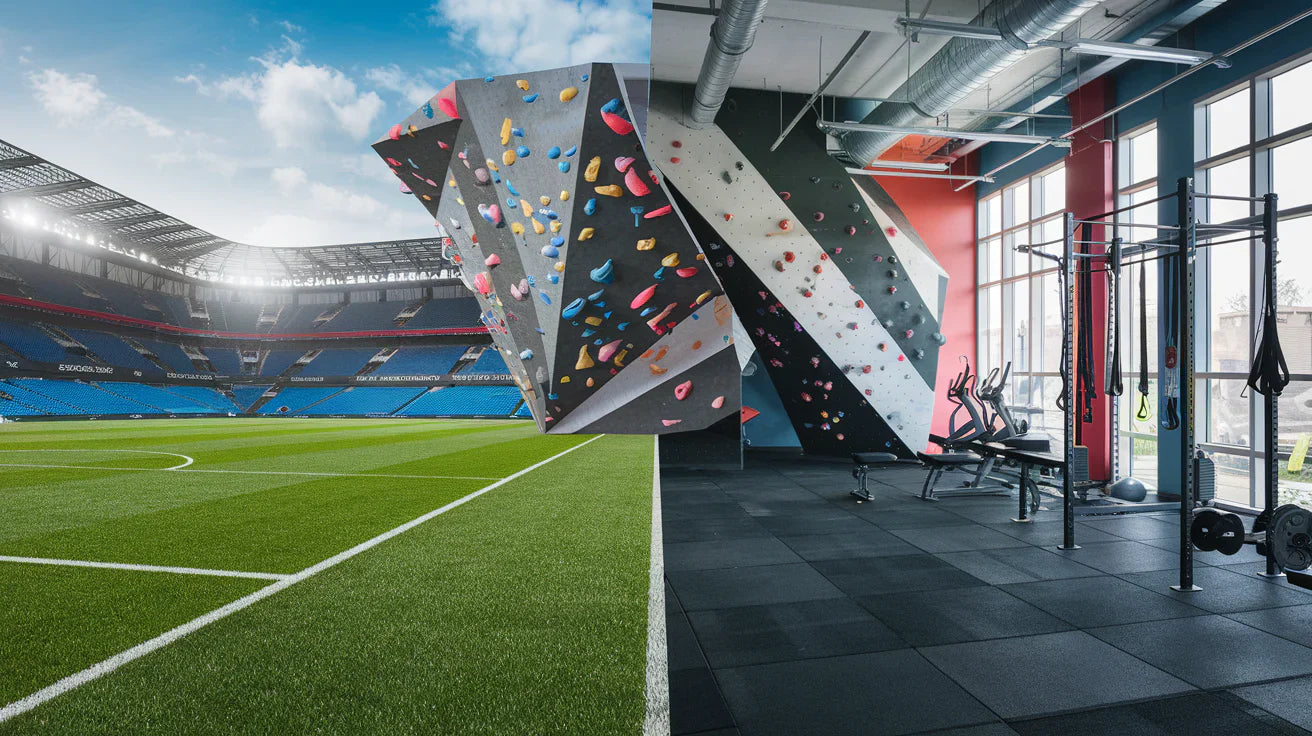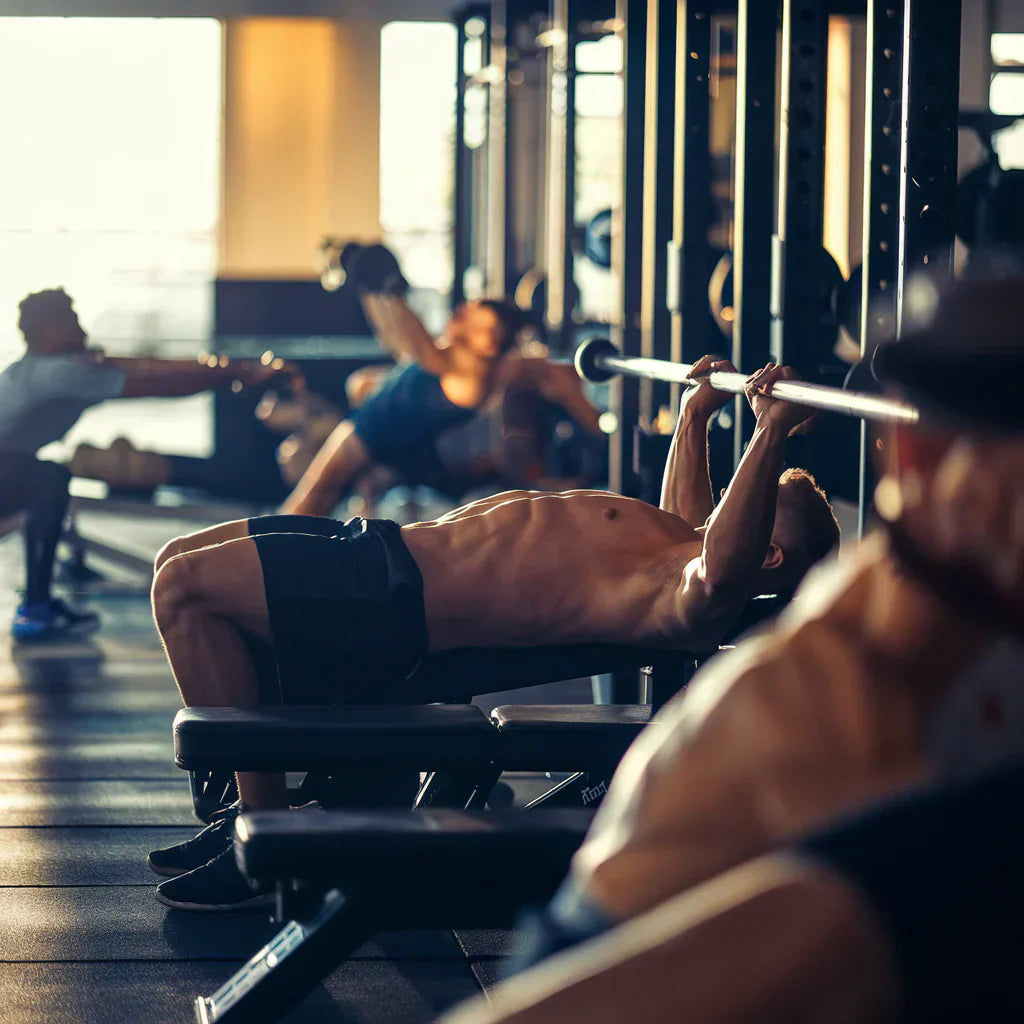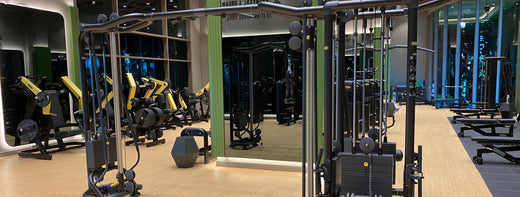Die Kombination von Krafttraining mit anderen Sportarten kann zahlreiche Vorteile bieten, aber auch einige Herausforderungen mit sich bringen. Nehmen wir als Beispiel das Fußballspielen: Hier ist eine gut entwickelte Muskulatur äußerst hilfreich, um sowohl Schnelligkeit als auch Ausdauer zu verbessern. Sollen jedoch beide Sportarten maximale Ergebnisse liefern ist ein sinnvoll gestalteter Trainingsplan essentiell. Zum Beispiel können Grundübungen, wie Kniebeugen und Kreuzheben integriert werden, um sowohl Beine als auch den Oberkörper zu stärken, was die Stabilität und Schnelligkeit auf dem Platz erhöht.
Jedoch besteht auch die Herausforderung, ein ausgewogenes Trainingsprogramm zu erstellen, das sowohl die Kraft- als auch die Ausdauereinheiten berücksichtigt. Anfänger können Schwierigkeiten haben, die richtige Intensität und das optimale Verhältnis von Kraft- zu Ausdauertraining zu finden. Fortgeschrittene Athleten müssen darauf achten, dass ihre Regeneration zwischen den Trainingseinheiten ausreichend ist, um Überbelastung zu vermeiden.
Die Synergien zwischen Krafttraining und anderen Sportarten sind enorm, wenn sie richtig kombiniert werden. Beispielsweise kann ein gut durchdachter Plan helfen, die Muskulatur gezielt aufzubauen und gleichzeitig die Leistungsfähigkeit im Fußball zu steigern. Wichtig zu betonen ist auch, dass eine Kombination von 2 Sportarten immer einen Kompromiss bedeutet. Doch wie können Athleten diese Trainingsmethoden effektiv integrieren, um ihre Fortschritte zu maximieren? Erfahre mehr darüber, wie du dein individuelles Trainingsziel erreichst!
Trainingstage und Frequenz
Die Kombination von Krafttraining mit anderen Sportarten erfordert eine durchdachte Planung der Trainingstage und Frequenz, um sowohl die Leistungsfähigkeit in der jeweiligen Sportart als auch die Erfolge im Krafttraining zu sichern. Ein sinnvoller Ansatz für einen Trainingsplan könnte eine Frequenz von drei bis vier Krafttrainingseinheiten pro Woche sein. Dabei ist es wichtig, die Regenerationszeit der Muskulatur zu berücksichtigen, um Überlastung und Verletzungen zu vermeiden.
Sowohl für Anfänger als auch für Fortgeschrittene ist ein Trainingsplan empfehlenswert, bei dem verschiedene Muskelgruppen an unterschiedlichen Tagen trainiert werden. Ein Beispiel könnte folgendermaßen aussehen:
- Montag: Push (Brust, Schultern, Trizeps)
- Dienstag: Sportart 2(z.B. Bouldern)
- Mittwoch: Unterkörper (Beine)
- Donnerstag: Sportart 2
- Freitag: Pull (Rücken, Bizeps)
- Samstag: Sportart 2
- Sonntag: Regeneration
Für fortgeschrittene Sportler, die ihre Muskeln gezielt aufbauen möchten, kann die Intensität der Krafttrainingseinheiten erhöht werden. Dabei sollte jedoch das Trainingsvolumen der einzelnen Muskelgruppen reduziert werden. Ein aktives Regeneration Management muss ebenfalls berücksichtigt werden. Zum Beispiel könnte es sinnvoll sein, die bei der ausgeführten Sportart am stärksten belastet Muskelgruppen im Krafttraining zu depriorisieren und diese im Training als letztes zu trainieren.
Die Verteilung der Trainingstage sollte so gestaltet sein, dass ausreichend Zeit für die Regeneration bleibt. Insbesondere nach intensiven Krafttrainingseinheiten ist es entscheidend, den Muskeln Zeit zur Erholung zu geben, um Fortschritte zu erzielen. Ein gezielter Einsatz von Proteinen zur Unterstützung des Muskelaufbaus sowie aktive Regenerationsmethoden, wie leichtes Stretching oder Yoga, können die Erholung zusätzlich fördern.
Durch die richtige Planung und Anpassung der Intensität kann jeder Sportler, ob Anfänger oder Fortgeschrittener, einen effektiven Trainingsplan erstellen, der sowohl Krafttraining als auch die Ausübung anderer Sportarten integriert und somit optimale Trainingsfortschritte sichert.
Volumen und Trainingsintensität
Um die Leistung in anderen Sportarten zu optimieren, ist es entscheidend, das Volumen und die Trainingsintensität im Krafttraining gezielt anzupassen. Das Volumen wird durch die Anzahl der Sätze und Wiederholungen bestimmt. Für Sportler, die mehrere Sportarten ausführen ist es ratsam, das Volumen niedrig zu halten, aber die Trainingsintensität zu erhöhen, ohne dabei das Nervensystem oder die Muskulatur zu stark zu beanspruchen. Fortgeschrittene Athleten sollten eventuell einen individuell erstellten Trainingsplan in Erwägung ziehen, um gezielt verschiedene Muskelgruppen an unterschiedlichen Tagen zu trainieren.
Die Trainingsintensität ist sehr wichtig und bezieht sich auf das verwendete Gewicht und den Grad der Anstrengung. Um den Kraftaufbau oder Muskelaufbau zu maximieren, sollte das Gewicht so gewählt werden, dass die letzten Wiederholungen eines Satzes eine Herausforderung darstellen. Ein häufiges Ziel im Krafttraining ist es, etwa 70-90% des maximalen Gewichts zu verwenden, das man einmal heben kann. Diese Intensität fördert nicht nur den Kraftzuwachs, sondern auch die Leistungsfähigkeit in der jeweiligen Sportart.
Eine ausgewogene Kombination aus Krafttraining und spezifischem Sporttraining sorgt dafür, dass die Gesamtfitness und die Leistung gesteigert werden. Beispielsweise können Fußballspieler von einer stärkeren Beinmuskulatur profitieren, während Schwimmer ihre Schulter- und Rückenmuskulatur gezielt trainieren sollten.
Für Anfänger empfiehlt es sich, mit leichteren Gewichten zu beginnen und sich auf die korrekte Ausführung der Übungenzu konzentrieren, um Verletzungen zu vermeiden. Fortgeschrittene Sportler können spezifische Workout-Einheiten einbauen, die gezielt auf die Anforderungen ihres Sports abgestimmt sind. So lässt sich der Erfolg im Training maximieren, und die Athleten erfahren eine spürbare Verbesserung ihrer Leistung.
Regeneration
Im Kontext der Kombination von Krafttraining mit anderen Sportarten spielt die Regeneration eine entscheidende Rolle für den langfristigen Erfolg und die Leistungsfähigkeit. Regeneration ermöglicht es dem Körper, sich von den Belastungen des Trainings zu erholen, Muskelgewebe aufzubauen und das allgemeine Wohlbefinden zu fördern. Eine angemessene Regenerationsstrategie ist daher unerlässlich, um Übertraining zu vermeiden und kontinuierlich Fortschritte zu erzielen.
Es gibt verschiedene Regenerationsmethoden, die Sportler nutzen können, um die Erholungsphase zu optimieren. Dazu gehören:
-
Aktive Regeneration: Leichte, lockere Einheiten, wie Joggen oder Radfahren, fördern die Durchblutung und helfen, den Muskeltonus zu reduzieren. Diese Form der Regeneration kann in den Trainingsplan integriert werden, um die Erholung zwischen intensiven Trainingseinheiten zu unterstützen.
-
Dehnen und Mobilisation: Das gezielte Dehnen der Muskulatur verbessert die Flexibilität und kann Muskelverspannungen lindern. Regelmäßige Dehneinheiten sollten Teil jedes Workouts sein, um die Beweglichkeit zu erhöhen und Verletzungen vorzubeugen.
-
Ernährung: Die richtige Nährstoffzufuhr Über den Tag ist entscheidend für den Erfolg des Sportlers. Das Essen sollte auf den Tagesablauf des Athleten abgestimmt sein. Und sowohl vom Körper gut verarbeitet werden können als auch schmackhaft sein. Wichtig ist, dass die Nährstoffe vom Körper auch aufgenommen werden. Dabei sollte man berücksichtigen. Du bist NICHT das, was du isst, sondern du bist das, was du verdaust.
-
Schlaf: Ausreichend Schlaf ist eine der effektivsten Methoden zur Regeneration. Während des Schlafs regeneriert der Körper nicht nur Muskeln, sondern auch das zentrale Nervensystem. Eine regelmäßige Schlafroutine sollte daher Teil jedes ernsthaften Trainingsplans sein.
Um Regenerationszeiten effektiv in einen Trainingsplan zu integrieren, sollten Sportler einen individuellen Trainingsplan in Betracht ziehen. Dies ermöglicht es, verschiedene Muskelgruppen an unterschiedlichen Tagen zu trainieren und ausreichend Zeit für die Regeneration zu lassen. Ein Beispiel könnte sein, an einem Tag Oberkörper und am nächsten Tag Unterkörper zu trainieren. So bleibt genügend Zeit für die Muskulatur, sich zu erholen und aufzubauen.
Indem man Regeneration als festen Bestandteil des Trainingsprozesses betrachtet, kann man nicht nur die körperliche Leistungsfähigkeit steigern, sondern auch langfristige Erfolge im Krafttraining und in anderen Sportarten erzielen.
Ernährung
Eine ausgewogene Ernährung ist entscheidend, um die Effekte von Krafttraining und anderen Sportarten optimal zu unterstützen. Der Nährstoffbedarf kann sich durch die Kombination verschiedener Sportarten erhöhen, da der Körper mehr Energie benötigt, um sowohl Muskelmasse aufzubauen als auch die Ausdauer zu verbessern.
Proteine sind unerlässlich für den Muskelaufbau und die Regeneration. Sie sollten in jeder Mahlzeit enthalten sein, insbesondere nach dem Workout. Eine gute Quelle sind mageres Fleisch, Fisch, Eier und pflanzliche Alternativen wie Hülsenfrüchte.
Kohlenhydrate spielen eine wichtige Rolle bei der Energieversorgung, besonders wenn du ein intensives Training im Fitnessstudio oder ein HIIT-Workout in deinem Trainingsplan hast. Vollkornprodukte, Obst und Gemüse sind hervorragende Optionen, um die Glykogenspeicher aufzufüllen.
Fette unterstützen ebenfalls die Regeneration und das allgemeine Wohlbefinden sowie die Hormonproduktion und sollten in Form von gesunden Quellen wie Nüssen, Avocados und Olivenöl konsumiert werden.
Praktische Tipps: Plane deine Mahlzeiten so, dass du vor und nach dem Training die richtigen Nährstoffe zu dir nimmst. Ein Snack mit Kohlenhydraten und Proteinen etwa 30 Minuten vor dem Training kann die Leistung steigern. Nach dem Workout ist eine proteinreiche Mahlzeit ideal, um den Muskelaufbau zu fördern und die Regeneration zu unterstützen.
Häufig gestellte Fragen:
Im Bereich des Krafttrainings gibt es viele Fragen, die sich Sportler und Fitnessenthusiasten häufig stellen. Besonders die Kombination von Krafttraining mit anderen Sportarten wirft oft Unsicherheiten auf. Egal, ob du ein erfahrener Athlet bist oder gerade erst mit deinem Trainingsplan beginnst, es ist wichtig, die richtige Balance zwischen verschiedenen Trainingsmethoden zu finden.
Eine gut durchdachte Kombination kann nicht nur deine Leistung in der jeweiligen Sportart verbessern, sondern auch das Risiko von Verletzungen verringern und deine allgemeine Fitness steigern. Daher stellen viele die Frage, wie sie ihren Trainingsplan optimal gestalten können, um sowohl Kraft als auch Ausdauer zu fördern.
In diesem Abschnitt werden wir einige der häufigsten Fragen beleuchten, die im Zusammenhang mit Krafttraining und anderen Sportarten auftauchen. Wir werden klären, wie man einen effektiven Split-Trainingsplan erstellt, der auf die individuellen Bedürfnisse und Ziele abgestimmt ist. Außerdem geben wir Tipps, wie man die verschiedenen Trainingsformen sinnvoll integriert, um die besten Ergebnisse im Fitnessstudio und darüber hinaus zu erzielen.
Wie sollte ich Krafttraining mit anderen Sportarten kombinieren?
Um Krafttraining gezielt in das Training anderer Sportarten zu integrieren, ist es wichtig, die spezifischen Bedürfnisse der jeweiligen Disziplin zu berücksichtigen. Ein gut strukturierter Trainingsplan kann helfen, Kraft und sportartspezifische Fähigkeiten zu kombinieren.
Zunächst sollte der Trainingstag in einem Split-Plan organisiert werden, der entweder auf bestimmte Muskelgruppen oder auf funktionelle Bewegungen fokussiert ist. Beispielsweise könnte ein Athlet, der im Fußball tätig ist, an einem Tag die Beinmuskulatur und am anderen Tag die Rumpfstabilität trainieren.
Praktische Tipps zur Gestaltung des Plans können beinhalten:
- Krafttraining im Fitnessstudio: Fokussieren Sie sich auf Übungen wie Kniebeugen, Kreuzheben und Bankdrücken, die die Grundkraft erhöhen.
- Sportartspezifische Übungen: Integrieren Sie Plyometrie-Übungen wie Boxsprünge oder Medizinballwürfe, um explosiv Kraft aufzubauen.
- Mobilitätsarbeit: Achten Sie darauf, Flexibilitäts- und Stabilitätsübungen in Ihre Routine aufzunehmen, um Verletzungen vorzubeugen.
Durch diese Kombination aus Krafttraining und spezifischen Übungen können Sportler ihre Leistung steigern und gleichzeitig das Risiko von Verletzungen minimieren.
Welches Gewicht, welche Anzahl von Wiederholungen, Sätze und Ruhezeiten sollte ich für mein Ziel wählen?
Um das richtige Gewicht, die Anzahl der Wiederholungen, Sätze und Ruhezeiten auszuwählen, ist es wichtig, zunächst das persönliche Ziel zu definieren:
-
Muskelaufbau (Hypertrophie): Hier empfiehlt sich ein Gewicht, das etwa 70-80% des maximalen Gewichts (1RM) beträgt. Ein typischer Plan könnte 3-4 Sätze mit 8-12 Wiederholungen und einer Ruhezeit von 90-180 Sekunden zwischen den Sätzen umfassen. Anfänger sollten mit leichteren Gewichten beginnen, während Fortgeschrittene die Intensität erhöhen können.
-
Kraftsteigerung: Für dieses Ziel sollten Sie schwerere Gewichte wählen, etwa 80-90% des 1RM. Ein Split von 4-6 Sätzen mit 3-6 Wiederholungen ist ideal, wobei die Ruhezeiten 2-5 Minuten betragen sollten, um die Muskulatur optimal zu regenerieren. Anfänger können mit weniger Sätzen und längeren Pausen beginnen.
Welche Übungen werden absolviert?
Krafttraining lässt sich hervorragend mit verschiedenen Sportarten kombinieren, um die Gesamtleistung zu steigern. Dabei können spezifische Übungen ausgewählt werden, die gezielt die Anforderungen anderer Sportarten unterstützen.
Krafttraining mit Ausdauersportarten: Läufer können von Übungen wie Kniebeugen und Kreuzheben profitieren, um ihre Beinmuskulatur zu stärken und die Laufökonomie zu verbessern. Ein Split-Training, das Ober- und Unterkörper fokussiert, ermöglicht es ihnen, gezielt Kraft aufzubauen, ohne die Ausdauer zu beeinträchtigen.
Krafttraining in Mannschaftssportarten: Im Fußball oder Basketball können Plyometrie-Übungen wie Boxsprünge und Medizinballwürfe die Explosivität und Schnelligkeit fördern. Diese Übungen verbessern die Fähigkeit, schnelle Richtungswechsel und Sprünge auszuführen, was entscheidend für den Erfolg auf dem Spielfeld ist.
Krafttraining im Kampfsport: Hier sind funktionelle Übungen wie Klimmzüge und Kettlebell-Swings von Vorteil. Sie stärken nicht nur die Rumpfmuskulatur, sondern verbessern auch die Griffkraft und Ausdauer, die für die Leistung im Ring entscheidend sind.
Die Kombination von Krafttraining mit diesen Übungen ermöglicht es Athleten, ihre spezifischen Fähigkeiten zu verfeinern und ihre sportliche Leistung auf ein neues Niveau zu heben.
Warum sollte ich mit einem Trainingsplan trainieren? Geht es nicht auch ohne?
Ein strukturierter Trainingsplan im Krafttraining ist entscheidend, um Fortschritte zu maximieren und Verletzungen zu vermeiden. Ohne einen Plan neigen viele dazu, sporadisch oder unsystematisch zu trainieren, was oft zu ineffektiven Ergebnissen führt. Ein gut durchdachter Trainingsplan hilft, spezifische Muskelgruppen gezielt anzusprechen und gezielt aufzubauen. So können Sie sicherstellen, dass alle wichtigen Bereiche Ihres Körpers ausreichend trainiert werden, was eine ausgewogene Entwicklung fördert.
Ein weiterer wesentlicher Vorteil eines Trainingsplans ist die Motivation durch klare Ziele. Wenn Sie wissen, was Sie erreichen möchten – sei es der Aufbau von Muskeln, die Verbesserung der Kraft oder die Steigerung der Ausdauer – können Sie Ihre Fortschritte besser verfolgen und sich selbst herausfordern. Zielgerichtetes Training erhöht die Wahrscheinlichkeit, langfristig am Ball zu bleiben.
Ohne einen klaren Plan kann das Training oft zu Frustration führen, da Fortschritte langsamer oder gar nicht sichtbar sind. Ein durchdachter Trainingsplan hingegen bietet nicht nur kurzfristige Erfolge, sondern auch langfristige Vorteile, wie eine verbesserte körperliche Fitness und ein geringeres Risiko für Verletzungen. Daher ist es ratsam, sich die Zeit zu nehmen, einen strukturierten Trainingsplan zu erstellen, um die gewünschten Ergebnisse effizient und sicher zu erreichen.
Welche Übungen sollten in meinem Trainingsplan sein?
Um die Vorteile des Krafttrainings optimal mit anderen Sportarten zu kombinieren, ist es wichtig, einen ausgewogenen Trainingsplan zu erstellen, der sowohl allgemeine Kraftübungen als auch sportartspezifische Bewegungen umfasst.
Allgemeine Kraftübungen:
-
Kniebeugen: Diese Übung stärkt die Beinmuskulatur und den Rumpf. Sie ist für nahezu jede Sportart relevant, da sie die Sprungkraft und Stabilität verbessert.
-
Bankdrücken: Ideal, um die Brust-, Schulter- und Armmuskulatur aufzubauen. Besonders wichtig für Ballsportarten wie Basketball oder Fußball, wo eine starke Oberkörperkraft von Vorteil ist.
-
Kreuzheben: Diese Übung fördert die Rückenmuskulatur und das gesamte Körperzentrum. Besonders nützlich für Sportarten, die Kraft und Stabilität erfordern, wie Rugby oder Gewichtheben.
Sportartspezifische Bewegungen:
-
Plyometrische Übungen (z. B. Boxsprünge): Diese verbessern die Explosivkraft und sind besonders relevant für Sprinter und Basketballspieler.
-
Rotationsübungen (z. B. Russian Twists): Diese stärken die Rumpfmuskulatur und sind entscheidend für Sportarten wie Tennis oder Golf, wo eine starke Rumpfdrehung entscheidend für die Leistung ist.
Durch die Kombination dieser Übungen in deinem Trainingsplan kannst du gezielt Kraft aufbauen und gleichzeitig die Leistung in deiner Sportart steigern.


